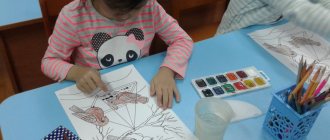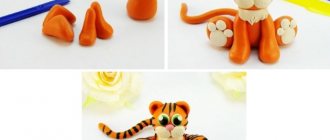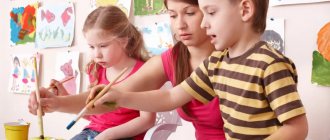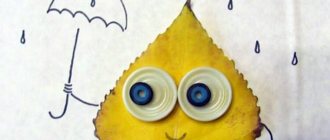Summary of a lesson on visual arts in the preparatory group of a kindergarten
Summary of a lesson on visual arts in the preparatory group of a kindergarten
Topic: Little Brothers - Soldiers. We need to remember their feat! Goal: to form the foundations of patriotism by introducing children to the role of animals that took part in the Great Patriotic War. Objectives: Educational:
1. To develop the ability to expressively convey images of animals in a drawing (body shape, location and shape of body parts, their size, proportions) based on a diagram.
2. Enrich children’s understanding of animals that took part in the Great Patriotic War. Developmental:
1. Develop technical skills and abilities in depicting animals.
2. Develop the ability to compose a plot composition based on a performance on a patriotic theme. 3. Develop the ability to write a story about your drawings and the drawings of your comrades. 4. Promote the development of perception, attention, memory and imagination. Educational:
1. Foster love for the Motherland, for nature;
humane treatment of animals. 2. Develop cooperation and co-creation skills. Materials and equipment: computer, presentation, phonogram of the song “Victory Day”, wax crayons, felt-tip pens, diagrams of step-by-step drawing of animals. Educational areas in integration: - artistic and aesthetic development - social and communicative development - cognitive development - speech development Preliminary work: examination of illustrations about animals in war;
reading poems, stories about animals that helped soldiers; compiling stories about animals based on paintings; modeling of animals. Course of the lesson
1. Introductory part Educator: There is a parade, fireworks are thundering, orchestras are sounding here and there, Not only great-grandfathers and grandfathers are celebrating the glorious Victory Day! The Great Patriotic War left a sad mark on the history of our country and the whole world. The feat of the Soviet people is difficult to overestimate. And few people know that at that terrible time, our smaller brothers proudly and bravely fought side by side with the soldiers. -Who do we call our little brothers? Children: Dogs, cats, horses, pigeons, dolphins... Educator: Today we will remember only some of them. 2. Main part Educator: (slide show)
Animals, like people, performed feats on the fields of war.
As heroes, animals saved thousands of human lives and brought the long-awaited Victory Day closer. Why do you think dogs served humans so faithfully? (children's answers)
.
That's right, dogs, as devoted and faithful friends of humans, performed a variety of tasks. It’s not for nothing that we respect the dog: The dog at the front was an orderly, a signalman, a sapper. Sometimes dogs rushed at tanks during an attack. Yes, during the war it turned out that the “tigers” and “panthers” were afraid of dogs. Educator: (slide show)
They took wounded soldiers from the line of fire and delivered ammunition to the battlefield.
Signal dogs delivered important orders. They pulled communication lines, looked for mines, and blew up enemy tanks. Dogs performed feats without knowing it. They simply did what people taught them and died, just like people. But by dying, they saved thousands of human lives. Educator: (new slide)
Despite the fact that World War II was called the war of engines, cavalry played an important role in it.
Educator: How do you think the horses helped the soldiers? (children's answers)
During the war, horses were used as a transport force, especially in artillery.
A team of six horses pulled the cannon, changing the firing positions of the battery. Food convoys and field kitchens were delivered to positions by horses. The wounded owed their lives to horses: most of the infirmaries were horse-drawn. Educator: (new slide)
Oddly enough, the symbol of peace - the dove - turned out to be very useful in war.
How could the pigeons help? (children's answers)
The army used carrier pigeons.
During the war years, carrier pigeons delivered a huge number of pigeon messages. The Nazis called them “feathered partisans.” Pigeons posed such a threat to the enemy that the Nazis specifically ordered snipers to shoot pigeons and even trained hawks on them. Educator: How can you ensure that your impressions of the knowledge gained remain in your memory as long as possible? So you can clearly share them with your friends? Children: You can draw your impressions. 3. Practical work. — Now you will try to convey your impressions of the story in drawings. Depict the animals that helped people on the WWII fronts. — Where do you start drawing any animal? (from the body)
- What shape is the body of the animal?
(oval)
- What shape can the head be?
(round and oval or elongated)
- What shape are the ears?
(triangular, oval, round)
- What shape are the paws?
(oval)
How many paws do animals have?
(four)
.
In birds? (two) (pay attention to the diagrams of animals)
- Guys, pay attention, animals have different colors and hair lengths.
— How should the animal be placed on the sheet? (large, in the center)
The animal can stand, walk, lie down, run.
The location of body parts relative to each other depends on this. (paws bent, extended, head turned, etc.)
- To start drawing, you need to stretch your fingers.
Finger gymnastics “Our true friends” One, two, three, four, five, (we bend the fingers on our right hand one by one)
Let us count our friends.
(we bend the fingers on the left hand one by one)
The closest, the most faithful -
(we connect the fingers of both hands one by one, Everyone probably knows them, big with big, etc.)
Dogs, horse, pigeon, cats
(we bend the fingers of both hands at the same time)
Let's clap their hands.
(clap our hands)
We were with the person next to us
(clasp our hands)
We served on the war fronts.
(we raise and lower our fingers)
We will see them here and there,
(we tilt the castle to the right and left)
Our fiery salute to them!!!
(raise our hands up and clap our hands)
Children sit at the drawing tables.
— Guys, think about which animal you remember most, which one you will draw. The tables have all the necessary materials. You can start working. (The children begin to work. The music “Victory Day” and others plays softly in the background.)
During the work, the teacher guides the children, encourages their initiative, asks leading questions, and draws the children’s attention to the diagrams of animal images.
— To color the background of the work, what technique can you use? (technique of drawing with a “die”) 4. Summary of the lesson Children display their finished works at the exhibition “Four-legged and winged war heroes.”
- Who will tell you about your drawing? — What title can you give to your work? — What works at the exhibition did you like? Educator: Much has changed since the war, but you and I must remember those who accomplished the feat, for the sake of life and for the sake of peace on earth. We must remember those who died, giving us the opportunity to see clear skies above our heads. Remember a person’s good friends who helped him on the difficult path to victory! Peace is the best word in the world, Adults and children strive for peace, Birds, trees, flowers on the planet. Peace is the most important word in the world! Presentation on the topic: Little Brothers - Soldiers
We recommend watching:
Scenario for a musical literary lounge for May 9 in kindergarten. Preparatory group
Similar articles:
War stories for schoolchildren
9th May. Victory Day scenario for elementary school
Where to celebrate Victory Day, May 9?
Scenario of the concert for Victory Day on May 9
Victory Day. 9th May. Scenario for kindergarten
MAGAZINE Preschooler.RF
“Magic Modeling” program for the senior groupGoal: Development of creative abilities in children of senior preschool age.
Objectives of the circle: introduce children to unconventional modeling techniques, coloring finished products; consolidation of knowledge about Dymkovo, Khokhloma, Gzhel paintings; fix relief, volumetric modeling; introduce the technique of making salt dough products; to develop an interest in performing creative works using different materials and methods; consolidate children's knowledge of materials that can be worked with and be able to use them correctly.
Explanatory note:
Our time requires creative, non-standard people who think and act for the benefit of the development of the individual and society. Therefore, the social order of society is to develop children’s creative abilities, the ability to think outside the box, not to be afraid to express opinions that differ from the generally accepted, to see the unusual in the ordinary.
According to psychologists and teachers, preschool age is the most favorable for the development of thinking and imagination - a mental process that forms the basis of creative activity. Therefore, the development of creativity is one of the main tasks of preschool education and upbringing.
The use of non-traditional modeling techniques in the practice of working with children works to solve several developmental problems at once:
- development of children's creative abilities (in all the diversity of this concept);
- development and improvement of fine finger motor skills;
- developing skills and abilities to work with various materials, devices and tools;
- acquaintance with new techniques and technologies;
- ability to apply them in practice.
Frequency of the circle: once a week for one academic year.
Duration of the circle: 25 minutes.
Expected student results:
Sculpts objects of various shapes using learned techniques and methods of sculpting;
Creates small plot compositions, conveying proportions, poses and movements of figures.
Creates images based on folk toys.
September:
1. Topic: “Apples and pears.” Gifts of autumn. Signs of autumn.
Goals and objectives: Practice rolling a ball, oval, flattening, using natural material to complement the craft.
Materials and equipment: Salt dough, dummies of fruits, stacks,
reproduction of paintings with fruits. (1/59)
2. Theme: “Sunflower”
Goals and objectives: Practice rolling a ball, oval, flattening, using natural material to complement the craft.
Materials and equipment: Salt dough, photo of a sunflower, stack, seeds. (11/14)
3. Theme: Decorative plate “Rose”. Gifts of autumn.
Goals and objectives: To develop the ability to sculpt a rose from individual parts, roll out balls, flatten, and make a flower of 6-8 petals. Develop finger flexibility and learn to see the end result.
Materials and equipment: Clay, stack (11/20, 3/61)
4. Topic: Painting the decorative plate “Roses” in the Gzhel style
Goals and objectives: To introduce children to folk art. Continue to develop the ability to paint products after drying, select paints, mix, to obtain the desired shade. Place the work on a plate.
Materials and equipment: Gouache, brushes, palette, dishes with Gzhel painting (8/85)
October:
1. Topic: “Prickly hedgehog.” Animal behavior in autumn.
Goals and objectives: Separately sculpt needles in the shape of a cone, connect the parts. Supplement the work with fungi and apples.
Materials and equipment: Colored salt dough, stack, slide with a picture of a hedgehog in the forest in autumn (11/12)
2. Topic: “The horse is beautiful, daring”
Goals and objectives: Continue to introduce children to folk art. Model a horse from a whole piece of clay. Develop finger flexibility and learn to see the end result.
Materials and equipment: Clay, stack, water, photo of the Filimonovsky horse (2/56)
3. Topic: “Kargopol goat”
Goals and objectives: Continue to introduce children to folk art. Model a horse from a whole piece of clay. Develop finger flexibility and learn to see the end result.
Materials and equipment: Clay, stack, water, photo of the Kargopol goat (1/112)
4. Theme: “Elephant”
Goals and objectives: Strengthen the ability to sculpt three-dimensional things and develop motor skills.
Materials and equipment: Plasticine, stack, photo of an elephant, sample of an elephant (5/14)
November:
1. Topic: “Ladybug” (on a leaf)
Goals and objectives: Learn to sculpt a ladybug from parts: head, body, using moldings, additional material for decoration. Use a leaf cutter. Be able to regulate the pressure when performing moldings.
Materials and equipment: Salt dough, leaf mold, toy, water, brush (12)
2. Topic: Coloring with “Ladybug” paints.
Goals and objectives: To develop skills of accuracy when coloring work. Be able to use unconventional drawing skills - with your finger, to draw dots. Exercise in ways of working with paints, designing work on a piece of paper.
Materials and equipment: Gouache, brush, glue (12)
3. Topic: “Panel with flowers” (sgraffito).
Goals and objectives: Familiarization with the technique of sgraffito - “scratched” on plasticine. plasticine,
Materials and equipment: cardboard, stack, painting with flowers
4. Topic: “Penguins on an ice floe.”
Goals and objectives: Continue to develop the ability to sculpt a figurine from a whole piece, using the techniques of rolling, stretching, flattening, cutting in stacks, conveying their characteristic features and proportions. Use foil when sculpting the body. Develop children's imagination and intelligence.
Materials and equipment: Salt dough, foil, foam. (11/8)
December:
1. Topic: Coloring with paints “Penguin on an Ice Floe”.
Goals and objectives: Continue to develop children’s ability to paint figures after drying, to combine them into a common composition. To develop children’s ability to accurately convey a conceived idea when coloring a product.
Materials and equipment: Gouache, brush, glue. (11/8)
2. Theme: “Christmas tree under the snow” (relief modeling)
Goals and objectives: Introducing children to a new modeling technique - plasticine stretching. Materials and equipment: plasticine, stack, card with Christmas tree (13)
3. Theme: “Snow Maiden”
Goals and objectives: To learn to reflect the impressions received while observing winter nature. Develop artistic and creative abilities.
Materials and equipment: Clay, model of the Snow Maiden (10/24)
4. Topic: Painting the Snow Maiden with Gzhel paintings.
Goals and objectives: Repeat the “Gzhel” painting with the children. Exercise in ways of working with paints, develop aesthetic perception and sense of color. Continue to develop the ability to see the end result of the planned work.
Materials and equipment: Gouache, brush, palette. Folk painting “Gzhel” (8/85)
January:
1. Theme: “Elegant Christmas tree”
Goals and objectives: To develop the ability in children to cut out a Christmas tree using a stencil, smooth out the edges with a brush moistened with water, and independently come up with decorations - balls, toys, beads. Develop finger flexibility. Use familiar sculpting techniques in a new creative situation.
Materials and equipment: Salt dough, “Christmas tree” stencil made of cardboard, stack, beads. (17)
2. Topic: Coloring with paints “Elegant Christmas tree”.
Goals and objectives: Continue to develop the ability to paint a Christmas tree with paints, develop skills of accuracy when doing work. Develop creative imagination and coherent speech when writing stories about the Christmas tree. When decorating the Christmas tree, use various additional materials
Materials and equipment: Gouache, brushes, glue, threads, beads, confetti. (17)
3. Topic: “Kargopol horse”
Goals and objectives: Continue to develop the ability to sculpt from a whole piece of clay.
Materials and equipment: clay, stack. (7/8)
4. Topic: “Decorating the Kargopol horse.”
Goals and objectives: To practice ways of working with paints, to develop aesthetic perception and a sense of color. Instill a love for animals and a desire to help them.
Materials and equipment: Gouache, brush, palette (7/8)
February:
1. Topic: “Bear-folk toy”
Goal: Continue to strengthen the ability to sculpt from a single piece. Introduce the traditions of potters.
Materials and equipment: plasticine, stack (9/10)
2. Topic: “Mug for Dad.”
Goals and objectives: To develop children’s ability to sculpt a mug, roll out plasticine in the form of a strip, a ball, press a depression in it, and pinch the edges. Sculpt the initial letter of the name for decoration. Develop fine motor skills and imagination in decorating a souvenir. Materials and equipment: Plasticine, stack (6/28)
3. Theme: “Hearts”
Goals and objectives: Consolidating the ability to sculpt objects or parts of them from dough, using the movement of the entire hand.
Materials and equipment: Colored salt dough, water
4. Topic: “Stork on the roof.”
February: Practice “painting over” a picture with plasticine. Cultivate an interest in creativity.
Materials and equipment: Plasticine, cardboard, cards with migratory birds, encyclopedia about birds (15)
March:
1. Topic: “Four-legged friend”
Goals and objectives: To develop the ability to use knowledge about the features of the appearance of animals in their work. Strengthen the skills and abilities acquired earlier (rolling, flattening, pulling, smoothing edges). Develop creative imagination and interest in work.
Materials and equipment: Stacks, plasticine, cardboard (10/28)
2. Topic: Signs of spring.”Flower meadow.”
Goals and objectives: Improving manual labor skills by modeling from colored dough.
Materials and equipment: Colored dough, stacks, water, slides with spring flowers (11/14)
3. Theme: “Basket with flowers”
Goals and objectives: Continue to develop children’s ability to roll out clay in an even layer, cut out a basket using a stencil, and scratch with a fork. Tie the flagella together for the handle and bottom. Sculpt familiar flowers and leaves. Develop imagination and the desire to give joy to others.
Materials and equipment: Clay, fork, basket stencil, stack. (11/14)
4. Topic: Coloring the basket and flowers.
Goals and objectives: To cultivate interest in creativity, collectivism, and aesthetic perceptions.
Materials and equipment: Gouache, brush. (11/14)
April:
1. Topic: “Amazing underwater world” (plasticineography)
Goals and objectives: Introduction to non-traditional drawing techniques (plasticine).
Materials and equipment: plasticine, stack (11/26)
2. Topic: “Rocket”.
Goals and objectives: To develop the ability to make a cone-shaped shape. Develop fine motor skills of the hands.
Materials and equipment: Salted dough, stack. Rocket photo (14)
3. Theme: Geometric man
Goals and objectives: Continue to develop children’s ability to paint crafts after drying, selecting the right colors. To develop the ability to accurately convey a conceived idea when coloring a product, to reveal the creative imagination of children in the process of work.
Materials and equipment: Clay, skewer, paints, brush (6/14)
4. Topic: “My dad is a fireman”
Goals and objectives: Continue to develop the ability to sculpt funny little people using the techniques of rolling balls, ovals, flattening, and pulling. Use matches and sticks to connect the parts. Develop the ability to work collectively.
Materials and equipment: Clay, matches, sticks, stacks (2/79)
May:
1. Topic: “St. George’s Ribbon.”
Goals and objectives: To develop the ability to roll out clay with a rolling pin and cut out shapes according to a template. Cultivate an interest in creativity.
Materials and equipment: Plasticine, template, stack
2. Theme: “Clover”
Goals and objectives: To consolidate the ability to roll balls of different sizes. Continue learning how to apply a relief pattern using a stack.
Materials and equipment: Plasticine, template, stack (3/38)
3. Topic: “Circus in Samara.”
Goals and objectives: Continue to develop the ability to notice and convey in modeling the characteristic features of an architectural structure.
Materials and equipment: Plasticine, stack, circus photo (16)
4. Topic: “Children on a walk.”
Goals and objectives: Continue to teach children how to convey movement in sculpting.
Materials and equipment: Plasticine, stack. (2/80)
Bibliography:
- Bondarenko T.M. “Complex classes in the senior group of kindergarten.” EC "Teacher", Voronezh, 2007
- Volchkova V.N., Stepanova N.V. “Lesson notes for the senior group of kindergarten”, Voronezh, 2008
- Davydova G.N. “Plasticineography. Floral motifs", M., 2009
- “From birth to school”, edited by N.E. Veraksy, T.S. Komarova, M.A. Vasilyeva M., Mozaika-synthesis, 2014.
- Petrova O. “Animals made of plasticine.” FST-PRESS KNIGA LLC, M., 2013
- Plomer A.L. “Making from clay” Kharkov, 2013
- Educational publication “Art for children. Kargopol toy. ed. "MOSAIKA-SYNTHESIS", M., 2008
- Utkin P.I. "Folk artistic crafts of Russia." M., 1984
- Educational publication “Art for children. We are making a folk toy.” ed. "MOSAIKA-SYNTHESIS", M., 2010
- Educational publication “Art for children. Khokhloma painting". ed. "MOSAIKA-SYNTHESIS", M., 2010
- Firsova A “Miracles from salt dough.” LLC "AIRIS-press", M., 2013
| Next > |
Planning art classes for November
Irina Sivirina
Planning art classes for November
Komarova T. S with elements Lykova I. A
NOVEMBER
1 WEEK
Lesson topic : Dymkovo toy.
Program content: introduce the Dymkovo toy, learn to draw patterns on a relief image
Materials for the lesson : stencil, cotton swabs, blue and white gouache paints, paper and cloth napkins, cups of water. Variable samples to explain the technique.
Komarova T.S. – p. 126 154
WEEK 2
Lesson topic : “Hail, hail!”
- drawing with cotton swabs.
Program content: teach children to depict clouds and hail with cotton swabs, changing the color and frequency of spot placement (spots on a cloud are close to each other, hail in the sky is more rare, with gaps). Show the relationship between the nature of the image and the means of artistic and figurative expression. Develop a sense of color and rhythm.
Materials for the lesson : sheets of blue paper, cotton swabs, blue and white gouache paints, paper and cloth napkins, cups of water. Variable samples to explain the technique.
Lykova I. A. s. 50.
WEEK 3
Lesson topic : “Beautiful balloons”
.
Program content: continue to teach children to draw round objects. Learn to hold a pencil correctly and use pencils of different colors during the drawing process. Develop an interest in drawing.
Materials for the lesson : colored pencils (the whole box, a landscape sheet of paper.
Komarova T.S. – p. 48
WEEK 4
Lesson topic : “Centipede in a store (polite conversation)
».
Program content: learn to draw complex-shaped images based on wavy lines, coordinate the proportions of a sheet of paper (background)
and the intended image. To develop the ability to perceive color and shape as the main means of artistic expression.
Materials for the lesson : long sheets or strips of paper in blue, yellow and light green (children’s choice), gouache paints (red, yellow, green, brushes, felt-tip pens (or pencils, paper and cloth napkins, cups ( jars)
with water.
Lykova I. A. s. 60
WEEK 5
Lesson topic : “Striped mugs for forest animals”
.
Program content: teach children to draw patterns of straight and wavy lines on a long rectangle. Show pattern (decor)
on the shape and size of the product (
“towels”
).
Improve your brush painting technique. Show options for alternating lines by color and configuration (straight, wavy)
. Develop a sense of color and rhythm. Cultivate interest in decorative and applied arts.
Materials for the lesson : long sheets of white paper, gouache paints of 2-3 colors, brushes, cups (jars)
with water, paper and cloth napkins. Variable patterns on a rectangle. Towels with beautiful patterns. Rope for an exhibition of children's works and decorative clothespins. Balloon for blowing soap bubbles.
Lykova I. A. s. 64.
Preparatory group. Senior preschool age. Children 6-7 years old
Art activity class “Magic New Year's ball” in the preparatory group
Visual activities, including drawing, modeling and appliqué, are one of the most interesting activities for preschool children. At the same time, visual activity is of invaluable importance for comprehensive aesthetic, moral,…
GCD for artistic activities in the preparatory group “Wild Animals. Squirrel" Goals: to teach to convey the texture of animal fur. Objectives: to develop visual skills. Material: Illustrations of wild animals Handout: tinted album sheet with a drawn outline of a squirrel, gouache, hard brushes, jars of water. Org. moment…




